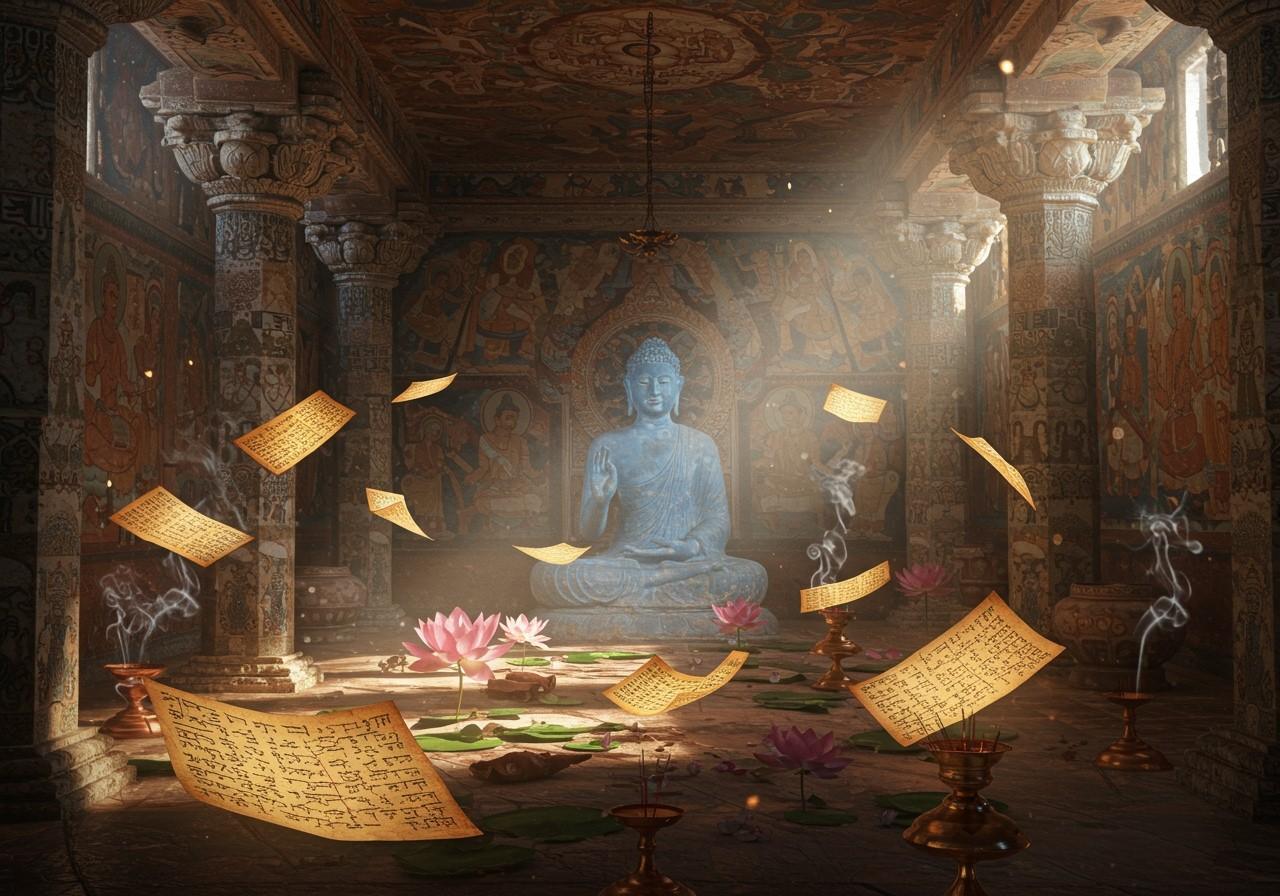
Explore the profound relationship between Buddhist texts and Indian history, understanding how ancient scriptures have shaped the cultural, social, and historical landscape of India. These texts preserve the rich heritage and traditions of India, offering valuable insights into ancient Indian civilization.
Major Buddhist Texts
Buddhist texts have contributed significantly to the understanding of Indian history. The Tripitaka (Pali Canon) is the foundational scripture of Theravada Buddhism, containing the Buddha’s teachings, monastic rules, and philosophical analyses. Other important texts include Mahayana Sutras, such as the Heart Sutra, a concise expression of emptiness, and the Diamond Sutra, which emphasizes the nature of reality. The Jataka tales narrate the previous lives of the Buddha, often incorporating elements of Indian folklore and social life, providing valuable historical context.
Buddhist Texts and the 16 Mahajanapadas
Buddhist texts describe the 16 Mahajanapadas, the great realms or republics of ancient India (circa 6th to 4th centuries BCE). References can be found in texts like the Anguttara Nikaya, a collection of numerical discourses, and the Mahavastu, a biographical text about the Buddha. These realms hold significance in India’s political and cultural history, with the texts providing geographical and demographic details that shed light on the era’s social dynamics and power structures. This period saw the rise of various states and the development of distinct political and social systems.
Depiction of India as Jambudvipa
Buddhist texts portray India as Jambudvipa, a term used in Buddhist cosmology to denote the “Island of the Rose-Apple Tree.” Texts like the Digha Nikaya, a collection of long discourses, and Majjhima Nikaya, a collection of middle-length discourses, describe India’s cultural and spiritual importance, particularly as the birthplace and heartland of Buddhism. They highlight India’s role as the center of Buddhist teachings and practices, emphasizing its spiritual significance within the broader Buddhist worldview.
Various Terms for India in Buddhist Texts
India is described using various terms in Buddhist texts. The term Bharatavarsha, with its historical implications, connects to ancient Indian epic traditions. References to cities like Kapilavastu, the Buddha’s birthplace; Rajagriha, the capital of Magadha; and Varanasi, a major religious and cultural center, show their importance in Buddhist history. These texts portray India’s diverse cultural and religious landscape, reflecting the complex interplay of various beliefs and practices during the period.
Influence of Buddhist Scriptures on Indian History
Buddhist texts have profoundly shaped Indian history. Ashoka’s edicts (circa 3rd century BCE), inspired by Buddhist teachings, promoted ethical governance, non-violence, and tolerance, influencing the Mauryan Empire’s administration and social policies. Buddhist monasteries and universities like Nalanda (established around the 5th century CE) served as centers of learning, preserving and transmitting knowledge across various disciplines, including philosophy, medicine, and astronomy. Buddhist art and architecture, evident in structures like the Sanchi Stupa, have significantly influenced Indian heritage, leaving a lasting legacy on the visual and artistic traditions of the subcontinent.
Poojn.in: Connecting You to Buddhist Heritage
Poojn.in, India’s leading online store for cultural and religious goods, provides a wide array of products that connect you with India’s rich spiritual heritage, including items related to Buddhist traditions. Explore our collection to discover:
- Tulsi Kanthi Mala: These traditional prayer beads are made from sacred Tulsi wood, commonly used in Buddhist practices for chanting and meditation. They are believed to promote peace and tranquility.
- Sandalwood Incense Sticks: Create a serene atmosphere for meditation and prayer with the calming fragrance of sandalwood, a scent highly revered in Buddhist traditions. These incense sticks are crafted using traditional methods to ensure purity and authenticity.
- Brass Statues and Sculptures: Poojn.in offers a diverse collection of brass statues depicting Buddhist deities and symbols, perfect for creating a sacred space in your home or for use in religious ceremonies. These beautifully crafted pieces serve as reminders of Buddhist principles and teachings.
Conclusion
Buddhist texts offer a rich tapestry of Indian history, culture, and spirituality. They provide detailed accounts of ancient realms, significant cities, and India’s portrayal as Jambudvipa. These scriptures have influenced India’s governance, education, art, and architecture. Studying these texts allows us to appreciate the profound impact Buddhism has had on shaping Indian heritage. Embracing this knowledge connects us to our roots and helps us understand the deep interweaving of religion and history in India.
FAQs
How did Buddhism challenge existing social norms in ancient India? Buddhism challenged the rigid caste system and the authority of the Brahmanical priesthood, offering a path to enlightenment accessible to all, regardless of social standing. This egalitarian approach resonated with many, contributing to its early popularity.
What led to the decline of Buddhism in India? Several factors contributed to Buddhism’s decline in India after the Gupta period (4th-6th centuries CE), including the resurgence of Hinduism with reformed practices, internal divisions within Buddhism itself, and the loss of royal patronage that had previously supported its institutions.
What is the significance of Nalanda and Vikramashila in Buddhist history? Nalanda and Vikramashila were renowned Mahayana Buddhist universities that flourished between the 5th and 12th centuries CE. They attracted scholars from across Asia, serving as major centers of learning and contributing significantly to the preservation and dissemination of Buddhist philosophy and other fields of knowledge.
For further exploration of Buddhist heritage and related products, visit Poojn.in.


